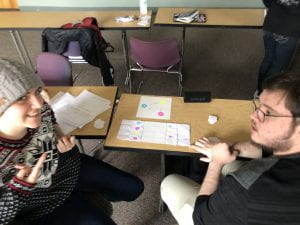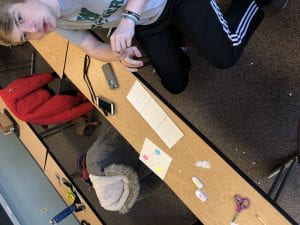Proversation
By Anthony Fanticola
This work intended to abstract the experience of attempting to bond with someone through conversation. This is a board game meant to simulate a conversation between two people in time. It is two player and the players work together to win. I drew out three elements of talking to someone and focused on representing them through the main mechanics. The first quality I represented is a conversations presence through time, and how something said can not be taken back. I used a 4X6 grid where the tiles must advance towards each other every turn in order to incorporate time. Different sections of the grid mark different phases of a conversation. Each player then generates their ‘ideas’ which is composed of four tiles in the four lanes on the far ends of the board. There are three types of tiles, pink, blue and yellow, each represent a distilled version of the types of things you can say in a conversation. The phases of a conversation are broken up into sections: the partners conceiving their ideas, sharing/saying the ideas, then having the ideas interact with each other.
The first section the tiles are placed face down to represent how in a conversation you don’t know what the person is thinking. When the tiles move to the second section they are revealed which represents talking in the conversation. When all these tiles match up perfectly in this phase, the partners have found a similarity and have won. If the tiles don’t all match they move into the last phase, located in the center eight spaces, where they interact and the dominate qualities (tiles) of the ideas stay in their final row and become awkwardness/the mood of the conversation. Each players tiles never advance over the center of the board. These tiles interact with a rock paper scissors mechanic across the center line that determines the dominance: which tile gets to stay in their center row. Jokes (Yellow) beat facts (blue), Facts (Blue) beat complements (Pink), Complements (Pink) beat Jokes (Yellow). If the tiles are the same, the tile that approached stays; if they arrived at the same time they are canceled out.
The drive to create a game like this comes from wondering what people are thinking during conversations and how they are interpreting what I am saying. I am often drawn to comedy because if I can make someone laugh I know for sure where there mind is at that moment. I feel a rush when discovering similarities with other people and on the contrary to some degree I am terrified of saying something or delivering an idea that causes awkwardness or dissimilarity. My goal with this work was to simulate the experience of talking to someone with the goal of bonding with someone by finding commonalities. The win state was obviously inspired by Mastermind, a childhood game of mine, and describes the state of mental similarity I am trying to simulate with great accuracy.
Originally i was not going to suggest what the colors represented but I found that players engaged with the peace more when they are slightly prompted by something like “yellow means joke’” and from that slight push I overheard players coming up with slight narratives to what might be going on in the conversation. The hyper abstract representation of a conversation between two people is definitely takes notes from of the abstraction within Rod Humbles “The Marriage.” In The Marriage the player, “imagines what the outside influences might be, and hazards guesses at what dark forces are represented by the circles.” In the game players are left to interpret what the reactions between certain shapes mean, and if it weren’t for the title it would probably not be understood as a representation of marriage. This player-generated narrative behind how shapes and colors interact is found in Proversation when the players were left to interpret what colored tile combinations meant when composing their ‘ideas’ and instinctively building a narrative around the interactions between certain types of tiles being dominated/eliminated by others.
Iterations:
The game went through many iterations in order to achieve a balance where the game was not to easy or impossible. The main rule that I had to experiment with a lot which seemed to determine the difficulty level is when to play the tiles face down or face up. The first iteration was all face down, the second all face up. During these trials the main win-state was also to survive the whole deck without building up too much awkwardness with the rare super win state where the players played the same cards. Also, awkwardness existed when a players card crossed a line on the other side of the board and counted against the players, too much awk and they loose. Then I began to focus the game more around the rare win-state of a perfect match. I began to balance when the cards would be revealed in the sections of the board then made a boundary that the cards couldn’t cross (eliminating the awkwardness building mechanic). The game now ends when the deck runs out. There are eight of each color type in each persons tile deck.


